Chapter: 11 th 12th std standard Bio Botany plant tree Biology Higher secondary school College Notes
Fruit : Types and Structure of fruit
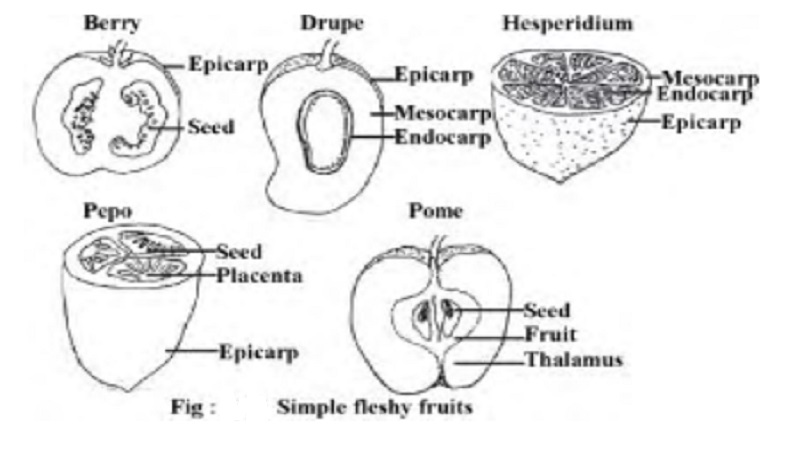
The fruit may be defined as a fertilized and developed ovary. Fruits and seeds develop from flowers after completion of two processes namely pollination and fertilization. After fertilization, the ovary develops into fruit. The ovary wall develops into the fruit wall called pericarp and the ovules inside the ovary develop into seeds. The branch of horticulture that deals with study of fruits and their cultivation is called pomology.
Fertilization acts as a stimulus for the development of ovary into fruit. But there are several cases where ovary may develop into fruit without fertilization. This phenomenon of development of fruit without fertilization is called parthenocarpy and such fruits are called parthenocarpic fruits. These fruits are necessarily seedless. eg. Banana, grapes, pineapple and guava etc.
The fruits are classified into two main categories, - true and false fruits.
True Fruit: The fruit, which is derived from ovary of a flower and not associated with any noncarpellary part, is known as true fruit. eg. Tomato, Brinjal, Pea, Mango, Banana etc.
False Fruit: (Pseudocarp) The fruit derived from the ovary along with other accessory floral parts is called a false fruit. eg. Apple(edible part of the fruit is the fleshy receptacle).
Structure of fruit
A fruit consists of two main parts - the seeds and the pericarp or fruit wall. The structure and thickness of pericarp varies from fruit to fruit. The pericarp consists of three layers - outer epicarp, middle mesocarp and inner endocarp. The sweet juicy and edible flesh is the mesocarp, the inner most hard covering is the endocarp. These three layers are not easily distinguishable in dry fruits.
The fruits are usually classified into three groups, namely simple, aggregate and multiple or composite fruits.
Simple fruits
When a single fruit develops from a single ovary of a single flower, it is called simple fruit. The ovary may be monocarpellary or multicarpellary syncarpous. On the nature of pericarp, simple fruits are divisible into two types
i) Fleshy fruits and ii) Dry fruits
Simple fleshy fruits
In these fruits either the entire pericarp or part of the pericarp is succulent and juicy when fully ripe. Normally the fruit wall may be differentiated into three layers - an outer epicarp, a middle mesocarp and an inner endocarp. As a general rule, the fleshy fruits are indehiscent.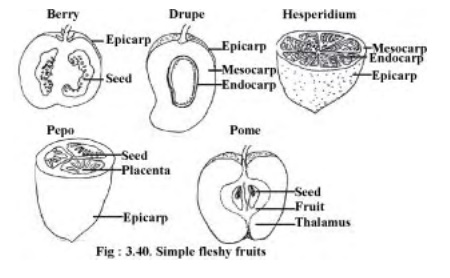
Fleshy fruits are broadly divided into two kinds, baccate and drupaceous. Baccate fruits are fleshy fruits with no hard part except the seeds. Berry is an example for the first category while drupe falls under the second type.
1. Berry: It is a many seeded fruit. Here the epicarp is thin, the mesocarp and endocarp remain undifferentiated. They form a pulp in which the seeds are embedded. In these fruits, all parts including the epicarp with the seeds are edible eg. tomato
2. Drupe: This is normally a one-seeded fruit. In these fruits the pericarp is differentiated into an outer skinny epicarp, a middle fleshy and juicy mesocarp and an inner hard and stony endocarp. Drupes are called stone
fruits because of the stony hard endocarp. The endocarp encloses F o llic le a single seed. The edible portion, i. Basifixed (Innate): Filament is attached to the base of the anther, eg. Brassica.
of the fruit is the fleshy mesocarp eg. mango. In coconut, the mesocarp is fibrous, the edible part is the endosperm.
Hesperidium: It is a skind of baccate fruit that develops from a superior multicarpellary and syncarpous ovary. The fruit wall is differentiated into three layers - an outer glandular skin or epicarp, a middle fibrous mesocarp, and an inner membranous endocarp. The latter divides the fruit chamber into a number of compartments. The seeds arise on axial placentae and are covered by juicy hairs or outgrowths from the lacentae that are edible.
It is characteristic fruit of the genus Citrus (Fam. Rutaceae)
Pepo: A large fleshy fruit developing from a tricarpellary, syncarpous, unilocular and inferior ovary with parietal placentation. The fruit is many seeded with pulpy interior; eg. Cucumber, Melon, Bottle gourd etc.
Pome: It is a fleshy and a false fruit or Pseudocarp. It develops from a multicarpellary syncarpous inferior ovary in which the receptacle also develops along with the ovary to become fleshy and enclosing the true fruit. The true fruit containing seeds remains inside. The edible part is fleshy thalamus. eg. Apple, Pear etc.
Simple Dry Fruits
These fruits have dry pericarp, which is not distinguished into three layers. The dry simple fruits are further divided into three types-
Dehiscent
Schizocarpic and
Indehiscent

Dehiscent dry fruits
Legume: A dehiscent dry fruit produced from a monocarpellary, superior ovary, which dehisces from both the sutures into two valves. eg. Pea
Follicle: A dehiscent dry fruit produced from a monocarpellary, superior ovary, which dehisces from one suture only. eg.Calotropis.
Siliqua: A dehiscent dry fruit produced from a bicarpellary, syncarpous, superior, ovary, which is unilocular but appears bilocular due to false septum.
Fruits dehisce along both the sutures from base to apex and large number of seeds remain attached to the false septum calledreplum. eg. Brassica
Capsule: A dehiscent dry fruit produced from syncarpous, superior or inferior ovary which dehisces along two or more lines of suture in various ways.
Septicidal - eg. Aristolochia
Loculicidal - eg. Gossypium, Abelmoschus
Schizocarpic dry fruits
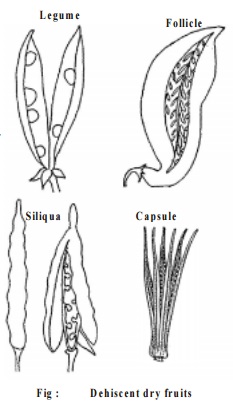
Lomentum: Fruit is similar to a legume but constricted between the seeds. Dehiscing sutures are transverse. The fruit splits into one-seeded indehiscent compartments at maturity; eg. Tamarindus, Cassia fistula.
Cremocarp: Fruit is produced from a bicarpellary, syncarpous, bilocular and inferior ovary. It is a two-seeded fruit which splits longitudinally into two indehiscent mericarps which remain attached to a thread-like carpophore. eg. Coriandrum
Regma: The fruit is produced from a bi- or multi-c a r p e l l a r y , syncarpous and superior ovary, it breaks up into as many segments or cocci as there are carpels; eg.Ricinus
Indehiscent dry fruits
Achene: A small, indehiscent one seeded fruit developing from a monocarpellary ovary and in which the pericarp is hard, leathery and remains free from seed coat; eg. Mirabilis, Clematis.Caryopsis: A small, indehiscent and one seeded fruit developing from a
monocarpellary ovary and in which the pericarp is fused with the seed coat. The seed completely fills the chamber; eg. Paddy, Maize
Cypsela: The fruit is produced from bicarpellary, syncarpous and inferior ovary with persistent calyx forming the 'pappus'. It contains only one seed. The pericarp and seed coat remain free; eg. Tridax, Helianthus.
Nut: A large, indehiscent, one-seeded fruit that develops from a bi- or multi-
carpellary ovary. The fruit wall becomes hard, stony or woody at maturity; etc. Cashew nut
Samara: A dry indehiscent, one-seeded winged fruit developing from
bicarpellary, syncarpous ovary. The wing is a modified outgrowth of pericarp; eg. Acer
Aggregate fruit
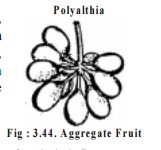
An aggregate fruit develops from a single flower, with multicarpellary, apocarpous, superior ovaries and each of them develops into simple fruitlets. An aggregate fruit, therefore consists of a collection of simple fruits as in Polyalthia. The carpels of the flower unite and give rise to a single fruit as in annona squamosa.
Multiple or Composite Fruit
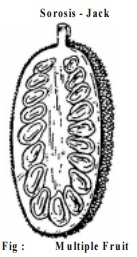
Multiple or composite fruit is formed by all the flowers of a whole inflorescence grouped together to give a single big fruit. In a sense, multiple fruits are false fruits.
In Jack, the type of multiple fruit is sorosis. The rachis and all the floral parts of the female inflorescence fuse together forming composite fruit. The inflorescence axis and the flowers all become fleshy.
In the centre of the fruit, there is a club-shaped, thick, fleshy central axis, which is the inflorescence axis. The edible part of the fruit represents the perianth, which is fleshy and juicy. The pericarp is bag-like and contains one seed. The spines on the tough rind represent the stigmas of the carpel. The sterile or unfertilized flowers, occur in the form of numerous, elongated, whitish, flat structures in between the edible flakes.
Sorosis: A multiple fruit that develops from a spicateinflorescence. eg. Ananas sativus (Pineapple).
Pineapple plant is largely cultivated for its fruits. The stem is short and leafy and bears a terminal spicate inflorescence. After fertilization, the axis and the flowers, along with the bracts, become stimulated to grow and unite together into a fleshy compound fruit, the 'Pineapple'. On the surface of the fruit, the hexagonal areas represent the flowers, and the tips of the floral bracts project out. Usually the flowers are sterile and seeds are rarely formed. The inflorescence axis produces a tuft of vegetative leaves, which forms a crown at the top. The vegetative top, if cut and planted, establishes itself in the ground and gives rise to a new plant.
Related Topics